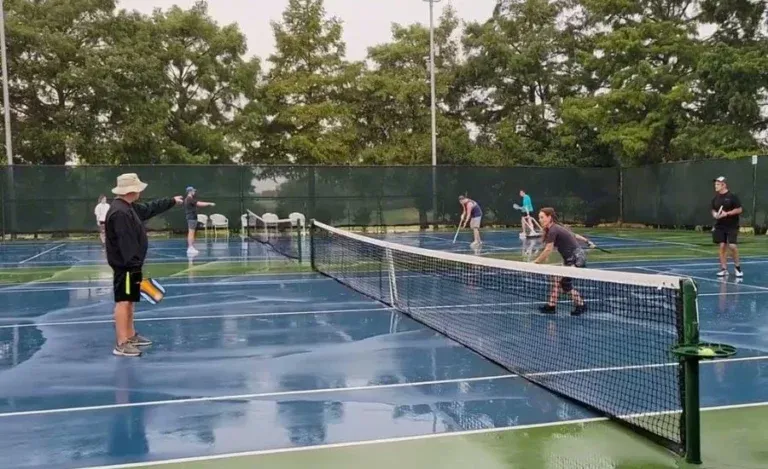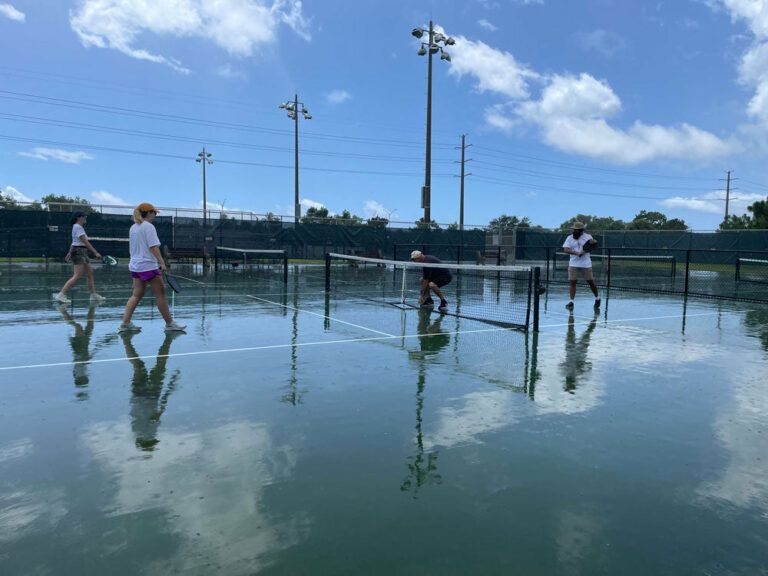Can you play pickleball in the rain?
Whether to play pickleball in the rain is a question that often stirs debate among players. While the technical answer is yes, it’s imperative to scrutinize the conditions before stepping onto the court. Light rain might seem bearable, but the consequences of wet courts can result in unexpected pitfalls, creating an atmosphere where players may need to reconsider their choice to play.
Understanding the risks of playing pickleball in the rain
In the realm of sports, safety should always reign supreme. This becomes especially true when discussing the potential hazards associated with a game played on wet surfaces. The slippery courts can transform even the most nimble athlete into a hesitant slow-motion figure, regressing to their childhood days of sliding across a slippery floor in gleeful abandon. Unfortunately, in pickleball, the slips are far from joyous; they can result in serious injuries ranging from sprained ankles to fractures.

Slippery courts and increased injury risk
With every drop of rain, the court becomes a canvas of danger, where falls lurk just around the corner. It's akin to ice skating without the ice skates; the potential for injury looms larger, necessitating a shift in mindset. Players often overlook how wet conditions may impact their agility and balance.
As a general rule, if the court is visibly wet, it might be prudent to postpone the game. Taking into account the unpredictable nature of the surface, players must remain vigilant and adhere to safety precautions designed to minimize the chances of falling.
Impact of rain on ball behavior
As the rain pelts down, it doesn't just affect the court but also the pickleball itself. The dynamics of how the ball bounces, its speed, and its trajectory are altered drastically in moisture. No longer can players rely on predictable rebound mechanics; the game might morph into a chaotic ballet where players must adjust their strategies on the fly, akin to navigating a stormy sea on a small boat.
When a ball meets a wet surface, instead of a reassuring bounce, it may plummet or bounce irregularly, leaving players guessing and struggling to adapt their shots. Therefore, understanding these changes is critical for anyone contemplating this slippery undertaking.
Potential for equipment damage
Beyond personal safety, the rain poses a hidden threat to your beloved pickleball equipment. Just as damp conditions can wreak havoc on eager players, they can also cause water damage to paddles, balls, and other gear. For instance, prolonged exposure to moisture can lead to paddle absorption, weakening the integrity of your equipment over time. The rust begins to corrode metal parts of the equipment, rendering them ineffective.
Furthermore, the life expectancy of balls can decline significantly, with increased wear making them less vibrant and effective on the court. Thus, it is often wise to consider the long-term implications of playing in the rain to protect your investments.
Making the decision: to play or postpone?
Before diving headfirst into a rain-tinged pickleball match, it’s vital to weigh your options carefully. The weather can shift from an innocent drizzle to torrential downpours in moments, transforming the court into a dangerous playing field that isn’t worth compromising your safety for.

Assessing the weather conditions
Begin by assessing the weather conditions for the day. Are you met with a light drizzle or a downpour? Understanding the rain intensity is crucial, as even a slight precipitation can turn a court into a slip-and-slide. Additionally, keep an eye on thunderstorm warnings or any accompanying lightning safety advisories; they should halt any plans to court.
Factors such as wind conditions can also affect not only your play but also how the rain hits the surface, making it key to ensure you’re aware of the overall climate before proceeding.
Exploring alternative options
If your enthusiasm to play remains strong despite adverse weather, consider alternative options. Indoor pickleball courts are an excellent alternative for those who don’t want to compromise their gameplay without risking injury. These courts provide a controlled environment, free from rain, while ensuring your rhythm isn’t interrupted.
Additionally, if you find yourself caught in the rain, postponing the game to a later time can preserve the health and safety of all players involved. Look for alternative activities that can bring you joy, such as practicing solo drills in a sheltered environment or engaging in exercises to keep your skills sharp until the weather clears.
Rainy day pickleball strategy: tips for adapting your game
When you choose to brave the elements, adjusting your game plan becomes essential to ensure success on slippery surfaces. Instead of relying on high-risk moves, adopt a strategy that accommodates the demands of the weather.
Choosing the right shots
To adapt to the unpredictable terrain, focus on choosing the right shots. A more soft game can stabilize play under adverse weather conditions, reducing the likelihood of sudden slips and unexpected outcomes. Instead of attempting aggressive power shots, practice dinking and volleying, where precision takes precedence over smashing the ball across the court.
Incorporating controlled play into your strategy can not only preserve your footing but also keep the game dynamic despite the weather challenges.
Adjusting footwork for a slippery surface
Footwork becomes paramount in the rain, where balance and stability arise as crucial factors. Moving too swiftly may result in mishaps; therefore, players should adopt shorter strides and controlled movements. Being mindful of how your foot interacts with wet ground will help keep you steadfast while engaging in movement.
The emphasis should shift towards ensuring stability rather than agility; a steady player can execute shots more accurately compared to someone racing around the court, risking an unfortunate slip.
Maintaining a positive mental game
Above all, cultivating a positive mental attitude can make or break your rainy day pickleball experience. Recognize that challenges will arise, as rain tests your adaptability and consistency. Emphasizing patience in navigating the slippery battleground will foster resilience, allowing you to manage expectations effectively.
Instead of succumbing to frustration, consider the unique challenge of playing pickleball in the rain as an opportunity to sharpen your skills while building camaraderie with other players facing similar conditions.
Pickleball drills for rainy days
Even when conditions aren’t ideal, there are still ways to improve your skills and refine your technique. Drills that minimize movement can keep your game sharp without sacrificing safety.
Stationary drills to improve technique
Focus on stationary drills that allow you to hone your skills without excessive movement. By concentrating on dinking drills, for instance, you can improve your touch and control without risking slips. Practicing volleys ensures that you remain engaged with the game while reducing the potential for injuries. Additionally, consider serving practice that requires only stationary positioning for optimal safety.
These drills not only keep your skills sharp but also instill confidence as you prepare for sunnier days when full mobility can be restored.
Drying a wet pickleball court: methods and techniques
If you find yourself faced with a wet court but still desire to play, there are several methods for drying off the surface effectively.
Using squeegees and push brooms
Manual drying techniques, such as using squeegees or push brooms, can be useful when attempting to remove surface water efficiently. Squeegees help push excess water off the court quickly, restoring playability in mere minutes.
The effectiveness of leaf blowers
For a more innovative approach, leaf blowers can come to the rescue. These devices serve to dry courts effectively by blowing air across the wet surface, dispersing droplets in a thoroughly efficient manner.
Using a combination of these techniques ensures that should you choose to play in the rain, you won’t be hindered by standing water.
Utilizing absorbent materials
In cases where water accumulation is persistent, making use of absorbent materials can further reduce wetness on the court. Towels or absorbent rollers can target areas where water gathers, providing crucial assistance in maintaining a playable surface.
Professional court drying equipment
For serious pickleball enthusiasts, investing in professional court drying equipment might be an attractive option. Utilizing powerful blowers or industrial-grade systems can quickly dry large areas of the court, ensuring minimal interruption in play.
This gear is beneficial for clubs or organized play spaces where consistent playing conditions are desired.
Protecting your pickleball equipment from rain
When playing in moisture-prone conditions, safeguarding your equipment becomes paramount. The right care can prolong your gear's lifespan and performance.
Proper drying techniques for equipment
Hanging paddles and balls in a well-ventilated area allows moisture to evaporate post-game. Air drying remains the best technique, coupled with a diligent inspection of your equipment for signs of damage.
Utilizing water-resistant bags and covers
Investing in water-resistant bags and covers can provide a protective layer against rain and moisture. This also facilitates moisture prevention, ensuring your paddle bags and ball storage remain unaffected by wet conditions.
Overall, keeping your equipment dry can lead to a more enjoyable game. Proper care ensures you can keep playing without major interruptions, even on rainy days.
Playing pickleball in other challenging weather conditions
Rain is just one of many adversities faced in the sport of pickleball. Learning to adapt to diverse conditions will enhance your overall game.
Adapting to windy conditions
Wind can be an invisible adversary, just waiting to transform your well-aimed shots into erratic disarray. Understanding wind direction is critical, as it guides your shot selection and court positioning. Think of it as sailing; the better you adapt to the force around you, the more control you have over your voyage.
Pickleball in extreme heat: safety and comfort
When faced with extreme heat, the focus shifts to hydration and sun protection. Implementing strategies to avoid heat exhaustion and safeguarding your body from the elements invites quality play without compromising your well-being.
Playing in cold weather
Lastly, playing pickleball in colder conditions can create its own set of challenges. Be mindful of the ball performance as temperatures drop, and ensure you wear appropriate clothing to keep warm. A prepared player manages both their gear and themselves for best results, regardless of the weather.
Finding indoor pickleball courts
If the elements become too overwhelming, shifting your games indoors may be the wisest decision.
Resources for locating indoor facilities
Explore websites, local sports clubs, or community centers to find indoor pickleball facilities nearby. Social media and local sports apps serve as excellent tools for discovering new courts and connecting with fellow players.
The advantages of indoor pickleball
Indoor pickleball courts provide consistent playing conditions, allowing enthusiasts to practice year-round, regardless of weather elements. Moreover, they offer protection from rain and other hindrances, ensuring your groove remains uninterrupted.
Conclusion
Ultimately, while playing pickleball in the rain is technically possible, the journey comes with its unique challenges and necessary adjustments. Keeping safety at the forefront and adapting to wet conditions can transform potential pitfalls into an entertaining challenge. With awareness and preparation, you can take to the courts, regardless of the weather, and continue honing your skills. However, always remember that your safety comes first; when in doubt, it may be wiser to wait for clearer skies or seek alternative playing options. The joy of pickleball lies not only in the game played but also in the camaraderie shared, regardless of what Mother Nature has in store.










